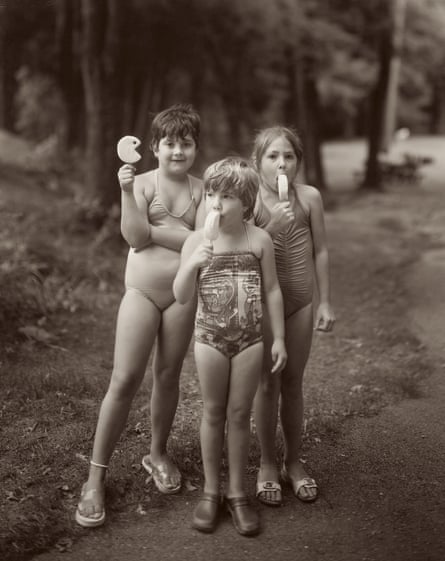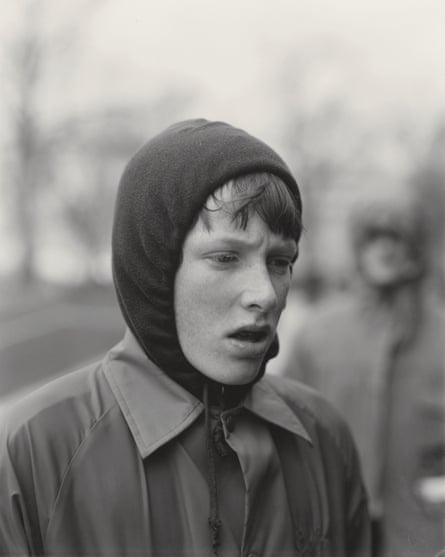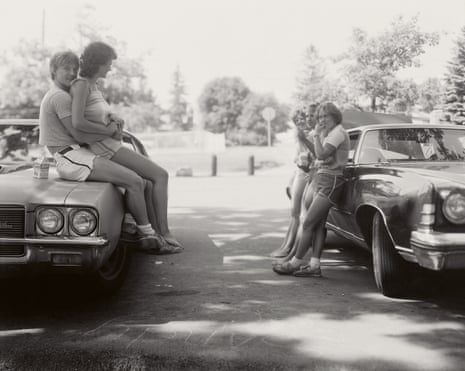Back in 1967, when Judith Joy Ross was a shy and awkward 20-year-old, still figuring out how to be a photographer, she used to take what she calls “sneaking pictures” of people on the street. “I had various little techniques,” she tells me. “Often I’d pretend to be working out how to use the camera, while I was actually shooting.”
How, I ask, did she conquer her self-consciousness and approach the myriad passing strangers, whose portraits now amount to one of the most singular and affecting bodies of work in American photography? “You pick a subject and you make yourself do it,” she replies. “That was hard for me. It was like, how much torture can I take? But, what I would see in a person, if only for a moment, was so wonderful, it was worth it.”
A conversation with Ross, who is now in her mid-70s, is an unpredictable ride. She is wise, hilariously funny and forthright – about herself and others. Oh, and she swears. A lot.

“As a photographer, you’re not supposed to be attached to your subjects,” she says at one point, “but I’m so fucking attached. I’m even attached to things that other people consider garbage. Basically, I just love things I’ve known for a long time.”
In a new retrospective book, Judith Joy Ross: Photographs 1978-2015, the things she loves – trees, rooms, windows, all rendered hauntingly beautiful – are outnumbered by the ordinary people she has met and made somehow extraordinary in her deftly composed, quietly revealing portraits. Alongside a retrospective exhibition of her work that has just opened at Le Bal in Paris, the book makes plain what many of her fellow photographers have been saying for years: that Judith Joy Ross may well be America’s greatest living portraitist.
The American documentary photographer, Gregory Halpern, recently called her “the greatest portrait photographer to have ever worked in the medium”. Alys Tomlinson, an acclaimed young British photographer, who acknowledges her as an influence, says: “I don’t understand why she isn’t more well known. Maybe it’s because she is drawn to people that you might well pass on the street and not notice. She elevates them with her camera. Her portraits are not neutral. There is an empathy on her side. A deep connection. She makes you look closely at her subjects, and think about them.” Interestingly Ross tells me that she seldom photographs rich people and “only sometimes” poor people. “I’m looking,” she says, “for people like me.”
For most of her working life, Ross has used an eight-by-10-inch plate camera mounted on a tripod, which, she says, “is so big and fucking beautiful, it disarms people. It’s like the circus has come to town! They feel special – most of the time, anyway.” Her portraits often exude an almost luminous quietude, their presence deepened by the blurred shadows and indistinct shapes in the background. It is as if everything extraneous falls away the moment she presses the shutter. When I suggest she has a signature style that many aspire to, but few attain, she says only half-jokingly: “All my pictures certainly look alike, which is kind of creepy to me. I was not seeking a style, though. The world can’t be defined.”
Ross grew up in Hazleton, a small coal mining city in Pennsylvania, where her father had a five-and-dime store and her mother taught piano. For an early series, Eurana Park (1982), she revisited an outdoor swimming pool in nearby Weatherly, which she frequented as a child. The portraits brilliantly evoke the languor of those long summers as well as the awkwardness of adolescence. In one, a young boy with a pudding bowl haircut stands stiffly holding a garden rake. In another, a teenage girl stares into the lens, her gaze so resolute that it takes a while to notice that her hair is wet and flattened from a swim, her forehead still dappled with tiny droplets of water. The details speak volumes about Ross’s concentrated gaze. “For me, making a photograph is tactile,” she says. “It’s sensual. I find the beauty that lies in the ordinary circumstances of the everyday. I don’t transform that ordinariness, though. I record it.”

The Eurana Park portraits were made in the shadow of her father’s death. “It was a very difficult time,” she says. “As a child, we’d go there on special days and it was like Brigadoon for me. Children playing, frogs, huge hemlock trees. When I went back there to photograph, I was mourning my father. He’s in the work somehow.”
One senses that her teenage years were not altogether happy. She singles out one image: a group portrait in which three girls gaze at a young couple perched on a nearby car. “The girl chewing her fingernails, that was me,” she tells me, matter of factly. “The social loser type person, who gets to observe, not be.” When I ask if she was adrift as a teenager, she says: “I’m still adrift. Back then, I would have said I was fucked up. For most people sexuality is a cool thing, but not for me.”
Her otherness had been intensified in the late 1960s, when she took a photography course at the Institute of Design in Chicago. Her tutor was the photographer Aaron Siskind, an iconoclast who elevated formal experimentation and abstraction over intuitive skill and craft. “I was a pretty lost person at grad school,” she says, “It stunk! Siskind would sit 30 feet away and look at prints and say things like, ‘This one has a quality.’ I didn’t know what the fuck that meant.” She spent most afternoons in the local cinema downtown. “I was not a healthy person,” she says. “I graduated because they could not have dealt with me for another year.”
In 1983, still grieving for her father, she travelled to Washington and began working on what would become her most celebrated series, Portraits at the Vietnam Veterans Memorial. Almost 40 years on, its quiet observational resonance remains undimmed, each portrait an acute glimpse of private contemplation. The wall itself, inscribed with the names of American dead, is an almost subliminal presence throughout. Instead, it is the faces that convey the weight of each individual’s private thoughts and, by extension, the inchoate grief of a divided nation.

“It was all motivation,” she says now, of the impulse that led her there. “The war was on TV every morning, when you were eating your Cheerios and milk. It was upsetting and it still is. I was young and I thought I was going to end the war with my photographs, as inappropriate as it was to go to the Vietnam memorial with a viewfinder and ask people if I could photograph them. I also had this crazy idea to do a requiem mass through my pictures. I mean, what the fuck was that about? I didn’t know shit about music.”
When the influential American curator, John Szarkowski saw the portraits, he choose 16 of them to include in a show called New Photography at the Museum of Modern Art in New York in 1985. Having been awarded a Guggenheim Fellowship, Ross had already embarked on what, in retrospect, is her least characteristic work, Portraits of the United States Congress. These were anything but ordinary people and she later said that, while photographing them in their work environment at the Capitol, she felt “intimidated over and over”. The results are surprisingly intimate, the expressions ranging from stoical to vulnerable. “I love the way reality looks in the most ordinary terms,” she says, “Even in the Congress, there are goofy things.”
The new book is a catalogue of ordinariness elevated, whether the hauntingly mysterious interiors of her family’s summer home in Rockport or the troubled faces of people staring from a vantage point at Eagle Rock, New Jersey towards the altered Manhattan skyline a week after 9/11.
Her house near Bethlehem, Pennsylvania, has a darkroom in the basement where she meticulously develops her prints, which are always roughly the same size as her 8”x10” negatives. She avoids the starkness of black and white by toning her prints in gold chloride, a painstaking process that, depending on the subject, lends them a grey or brown aspect.
“I began doing that with the Eurana Park pictures,” she elaborates. “Some, like the three little girls with popsicles, are printed brown because they are full of joy. Others, mainly of the older kids, are printed grey because I could sense they already had the basic existential issues that adults have. That series has an awareness that life is going to be hard. Period. For me, the greyness is our mortality. I would not have said that back then, but I found myself saying it to myself yesterday when I was thinking about the pictures.”
At present, Ross is suffering from an eye problem following pre-pandemic surgery that has left her with double vision. “I can photograph,” she say, “but it’s hard to take a walk.”
One senses that photography gave her a way to be in the world. “I’m just interested in people, but I don’t want to get too close to them,” she says. “I keep them at arm’s length with the camera. It’s like a magic charm. It’s such an intense pleasure to photograph strangers because, in that moment, you can see them in such an intimate way. It’s kind of crazy, but I love some of those people even though I have never seen them again.”

Comments (…)
Sign in or create your Guardian account to join the discussion